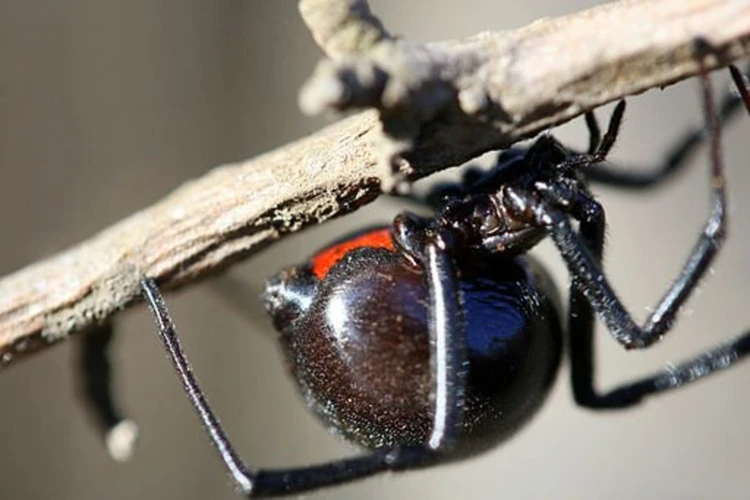Have you ever come across a spider and found yourself wondering if it might be a black widow? These venomous spiders are notorious for their painful bite, and identifying them can be important in both indoor and outdoor settings. But how exactly can you recognize a black widow spider, and where are they most likely to hide? In this comprehensive guide, we will explore everything you need to know about identifying black widow spiders and their most common hiding spots. From practical prevention tips to dealing with infestations, we will provide you with all the information you need to stay safe and spider-free. So grab your magnifying glass and get ready to uncover the mysteries of black widow spiders.
Identifying Black Widow Spiders
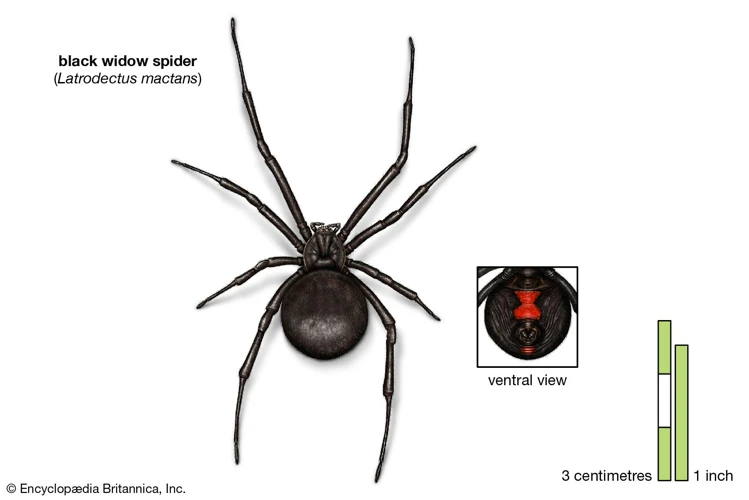
As summer approaches, it’s important to be aware of the presence of black widow spiders in and around your home. Identifying these venomous spiders is crucial for protecting yourself and your family from potential danger. Black widow spiders are known for their distinctive appearance and potentially fatal bite. Keep reading to learn more about how to identify these spiders and what habitats they commonly occupy. And if you want to know more about the risks of black widow spiders in basements, you can check out our article on Black Widow Spiders in Basements.
Behavior and Anatomy
Black Widow spiders are one of the most commonly known venomous spiders in the world. These spiders are generally found in warm and dry environments. Their appearance is characterized by their shiny black coloring, with a defining hourglass-shaped red marking on the underside of their abdomen.
Behavior:
Black Widow spiders are not aggressive and tend to retreat from humans whenever possible. They are shy and docile, and generally keep to themselves in secluded hiding places. However, when provoked, they can become aggressive and bite. They will often stay hidden in their hiding spot while waiting for prey, minimizing the potential for conflict.
Anatomy:
Black Widow spiders are small, with females often larger in size than males. The adult female typically grows up to 1.5 inches long, while males are only slightly more than half that size. The black widow spider is identified by its distinct hourglass marking on the underside of its abdomen, which is a warning sign for possible danger to humans. The spider’s body is divided into two basic parts, the cephalothorax (the head and thorax combined), and the abdomen. They have eight legs and two body sections.
One interesting aspect of black widows is that they produce highly toxic venom that’s specifically designed to slow down and paralyze their prey. However, their venom is not as potent in humans. The venom is known to cause a range of symptoms, from mild pain and discomfort to severe reactions such as seizures and respiratory failure.
Understanding the behavior and anatomy of Black Widow spiders can help people identify them with ease. However, Black Widow spiders can be mistaken with other spider species. Let’s take a look at some of the common misidentifications in the next section.
Common Misidentifications
Misidentifying a black widow spider can be dangerous, as it may lead to improper handling of a venomous spider. The following table highlights some of the most common misidentifications of the black widow spider:
| Misidentification | Description | How to Tell |
|---|---|---|
| False widow spider | Resembles the black widow, but with less distinct markings and a less harmful bite. | Look for the hourglass shape on the underside of the abdomen. False widows may have stripes or spots instead. |
| Wolf spider | Large and hairy, often mistaken for tarantulas. Not venomous but can deliver a painful bite. | Look for the absence of an hourglass shape on the abdomen. Wolf spiders are generally larger and hairier than black widows. |
| Brown widow spider | Lighter brown in color with an orange hourglass shape. Usually found in Florida. | Pay close attention to the color and shape of the hourglass on the abdomen. Brown widows often have a different pattern than black widows. |
| Jumping spider | Small and usually brightly colored. Known for their jumping ability. | Jumping spiders lack the distinctive hourglass shape on the abdomen and are generally smaller. |
It is important to note that juvenile black widow spiders may also be mistaken for other less harmful spider species. Take caution when handling any unfamiliar spider and consult a professional for proper identification if necessary. If you suspect a black widow spider infestation, it’s important to take action immediately.
Why Black Widow Spiders Hide
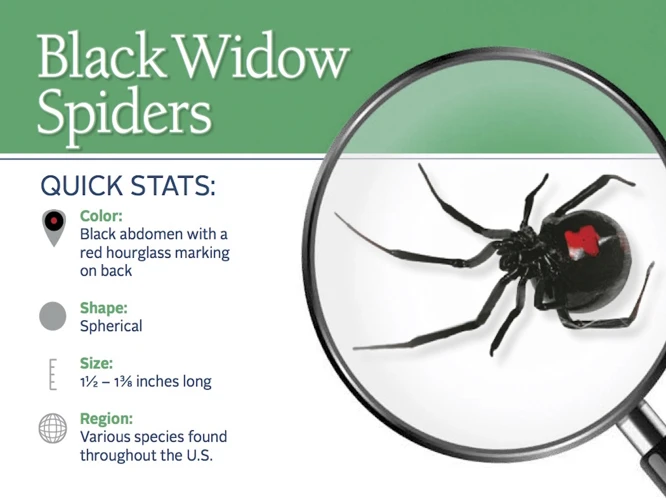
It can be perplexing to wonder why black widow spiders prefer certain hiding spots. However, understanding their behavior can shed light on why they choose particular locations. Black widow spiders are known to hide for a variety of reasons, including protection from predators, finding shelter for reproduction and nesting, and the pursuit of their natural habitat. Let’s explore the reasons why these spiders are frequently found hiding in certain areas both indoors and outdoors.
Natural Habitat
Black Widow Spiders are commonly found in warm and dry regions of the world, particularly in North and South America. Black Widow Spiders often prefer to live in areas that provide escape from direct sunlight and moisture to keep their bodies dry. They are commonly found in dark and quiet places, particularly in abandoned buildings, cluttered areas, and piles of debris.
Table 1: Natural Habitat of Black Widow Spiders
| Habitat | Description |
|---|---|
| Abandoned buildings and cluttered areas | Black Widow Spiders often hide in undisturbed and quiet places such as abandoned buildings, storage areas, and cluttered spaces where they can find shelter from direct sunlight. |
| Debris and piles of wood | Black Widow Spiders are commonly found in piles of debris and wood such as firewood, lumber piles, and compost heaps. |
| Landscaping and outdoor areas | Black Widow Spiders may be found in gardens, bushes, trees, and other outdoor areas if they provide enough cover from direct sunlight and access to prey. |
| Moist and damp areas | Black Widow Spiders may hide in areas with high humidity levels such as basements, crawl spaces, and attics. Additionally, they may also be found in areas with standing water. |
It’s also important to note that Black Widow Spiders construct their nests in protected and secluded places. They will often use existing cracks and holes within their habitats to build their nests. They prefer locations that are elevated to increase the likelihood of finding prey.
It’s essential to maintain a clean and orderly environment to prevent Black Widow Spiders from making themselves at home. By eliminating clutter, sealing cracks, and keeping outdoor areas tidy, you can reduce the chances of Black Widow Spiders nesting in your home or backyard.
Predators
Black widow spiders have a number of predators, which is one of the reasons why they tend to hide in secluded locations. If they are out in the open, they are more likely to be spotted by predators such as birds, lizards, and other spiders. These predators can be helpful in controlling the black widow spider population in a given area.
However, if black widow spiders start to infest an area and their numbers become too high, their prey may become scarce, and their predators may not be enough to keep their population under control. This is why it is important to keep an eye out for signs of a black widow spider infestation.
If an infestation is suspected or confirmed, steps should be taken to get rid of the spiders and their nests. As previously mentioned, black widow spider nests can be found in a variety of locations, so it is important to be vigilant. Some helpful tips for finding and eliminating black widow spider nests can be found in the articles ‘/black-widow-spider-nests/’ and ‘/keep-black-widows-out-garage/’.
It is also important to keep children and pets away from areas where black widow spiders may be hiding. This is especially true when it comes to outdoor play, as black widow spiders may be lurking in the shadows of toys, equipment or sports gear. To learn more about the risks associated with outdoor play and how to prevent black widow spider bites in children, check out the article ‘/black-widow-spider-risks-outdoor-play/’.
In addition to being careful when playing outside, it is important to keep indoor spaces free of clutter. Black widow spiders often hide in quiet, undisturbed areas, such as garages, closets and attics, where they are less likely to be disturbed. To learn more about how clutter can contribute to a black widow spider infestation, check out the article ‘/black-widow-spider-clutter/’.
Black widow spiders can also hide in firewood piles, another reason for keeping wood piles away from the house. to know more about black widow spiders and the danger posed by firewood piles, check out the article ‘/black-widow-firewood-danger/’.
In terms of outdoor areas, black widow spiders may hide in landscaping such as overgrown bushes, dense grasses, or piles of leaves or yard debris. To learn more about how to adjust outdoor landscaping to prevent black widow spider infestations, check out the article ‘/black-widow-spiders-landscaping/’.
Lastly, it is important to note that as juvenile black widow spiders grow, their hiding habits may change. While they may prefer secluded, damp locations when they are young, they may become more adventurous as they mature. To learn more about juvenile black widow spider habits, check out the article ‘/juvenile-black-widow-spider-habits/’.
Reproduction and Nesting
Black widow spiders are most active in warmer months when they are breeding and nesting. The female black widow spider is known to be highly aggressive and territorial when it comes to protecting her eggs.
Reproduction: Female black widow spiders are capable of laying up to nine egg sacs, each containing around 200 eggs. They prefer to lay their eggs in a warm, dark, and secure location, free from predators. In general, black widow spiders mate during the spring and summer months, with the male approaching the female with caution and carefully weaving his way around her web in an attempt to avoid being attacked.
Nesting: Black widow spiders prefer to nest near the ground, usually in locations such as woodpiles, debris, and cluttered areas around homes or businesses. They tend to hide in crevices, corners, or other tight spaces where they can easily defend themselves against predators.
To avoid encountering potential black widow spider nests, it’s important to keep clutter and debris to a minimum around your home. Remove leaf litter, woodpiles, or other decaying organic matter that could serve as ideal nesting spots. Be sure to seal any cracks or crevices in your walls, windows, and doors to prevent them from entering.
It’s also worth noting that black widow spiders tend to gravitate towards damp places, like basements, crawl spaces, and other dark areas, as these areas provide an optimal environment for them to thrive. Ensure that you keep these areas clean and dry to discourage nesting.
If you suspect that you have a black widow spider infestation, take your safety seriously and do not attempt to remove them yourself. Call a professional pest control company who can safely and effectively remove the spiders while minimizing the risk of bites or other injuries.
For more information on the threats of yard debris to black widow spiders, check out our article on “The Threats of Yard Debris to Black Widow Spiders.”
The Most Common Hiding Spots for Black Widow Spiders
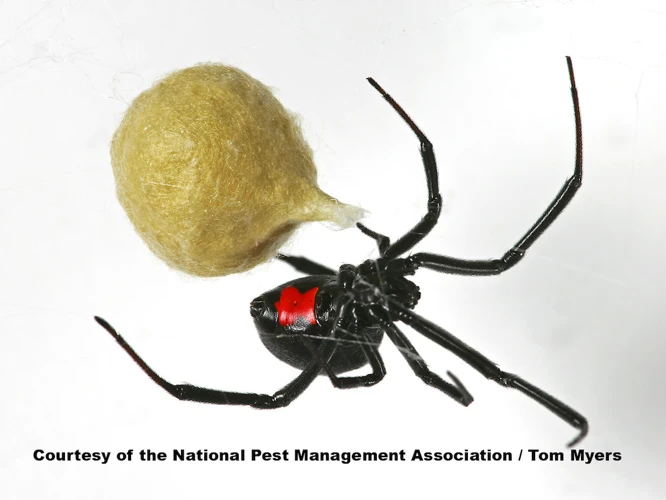
Black widow spiders are well-known for their potentially dangerous bites and elusive nature. Identifying their most common hiding spots can be crucial in preventing infestations and avoiding encounters. These spiders can find shelter in various environments, from indoor spaces to outdoor landscapes. In this section, we will highlight some of the most popular hiding spots and offer suggestions on how to eliminate these pests from your living spaces. Keep reading to learn more about the black widow spider’s preferred hiding spots and what you can do to prevent or identify infestations.
Indoors
Indoors, black widow spiders are often found in dark, undisturbed areas with clutter, which provide the perfect hiding spots. Here are some of the most common places to find black widow spiders indoors:
– **Basements and crawl spaces**: These areas are typically dark and damp, and black widow spiders love moisture. They may hide in boxes, piles of clutter, or under furniture. Keep these areas clean and dry to prevent infestations.
– **Closets**: Black widow spiders are known to hide in shoes, clothing, and other items in closets. Be sure to shake out and check your clothing and shoes before wearing them, especially if they’ve been sitting in a closet for a while.
– **Garages and sheds**: These areas often have piles of clutter and debris that make great hiding spots for black widow spiders. Keep your garage and shed organized and free of debris to prevent infestations.
– **Attics**: Black widow spiders may hide in insulation, boxes, or other clutter in attics. It’s important to keep these areas clean and organized, and to seal any cracks or openings where spiders may be entering.
– **Behind furniture**: Black widow spiders may hide behind or under furniture, particularly in areas that are seldom used. Be sure to move furniture periodically and thoroughly clean the area behind it.
Remember, if you see a black widow spider indoors, there are likely more hiding somewhere nearby. Take precautions, such as wearing gloves, to avoid accidental bites, and call a professional pest control company for help with removal and prevention.
If you want to know more about why black widow spiders love damp places, check out our article on black widow spider habitats.
Outdoors
Black widows are commonly found hiding in various outdoor locations as well. Below we will describe some of the most common areas to check for black widows if you suspect an infestation in your outdoor spaces.
| Outdoor Location | Potential Hiding Spots |
|---|---|
| Garages and Sheds |
|
| Yard and Garden |
|
| Outdoor Furniture |
|
| Gutters and Eaves |
|
It’s important to take necessary precautions when checking these outdoor areas, as black widows can be easily disturbed and become aggressive if they feel threatened. Wear protective clothing such as gloves, closed-toed shoes, and long sleeves to avoid any accidental bites. If you find any black widows in your outdoor spaces, it’s important to take appropriate measures to remove them and prevent future infestations.
Unusual Hiding Spots
Black widow spiders are known for their love of hiding, and they can often be found in some of the most unexpected places. It’s important to be aware of these atypical hiding spots in order to effectively identify and eliminate black widow infestations in your home.
Here are some of the most unusual hiding spots where black widow spiders may be found:
| Hiding Spot | Description |
|---|---|
| Clothing and Shoes | Black widow spiders may crawl into shoes, boots, and clothing left outside or in a dark closet. |
| Mailboxes | Black widow spiders may spin webs and nest in mailboxes. Be sure to wear gloves when checking your mailbox. |
| Outdoor Furniture | Black widow spiders may choose to hide in cushions, on the underside of tables or chairs, and in other crevices on outdoor furniture. |
| Plants and Shrubs | Black widow spiders may spin webs and nest in the leaves and branches of plants and shrubs. Be cautious when gardening or pruning. |
| Children’s Toys | Black widow spiders may hide in toys left outside or in garages or sheds. |
| Electronics | Black widow spiders may crawl into electronic devices, especially if they are located in dark, warm places. |
Always be alert and on the lookout for black widow spiders in unusual places in and around your home. By being aware of their hiding spots, you can take preventative measures to keep these venomous spiders from making a permanent home in your living space.
Signs of Black Widow Spider Infestation
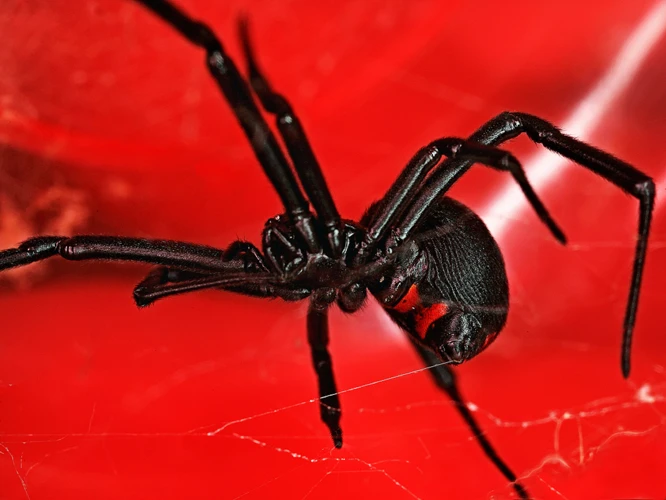
If you suspect that black widow spiders have taken up residence in your home or yard, it’s important to be able to identify signs of their infestation. These spiders can be stealthy, hiding in dark corners and crevices, so it’s vital to know what to look for. By being aware of the unique patterns of their webs, their appearance, and the symptoms of their bites, you can take action to protect yourself and your family. Let’s dive into some of the key signs of black widow spider infestations.
Web Patterns and Locations
Black widow spiders are known for their distinct black coloration and the red hourglass-shaped marking on their abdomen. But another way to identify whether or not you have a black widow infestation is to look for their web patterns and locations. These spiders tend to weave webs that are irregular in shape and typically closer to the ground. Here is a table detailing some common black widow web patterns and locations:
| Web Pattern | Location |
|---|---|
| Irregular shape | Corner of a room or basement |
| Disorganized and tangled | Garage, shed, or woodpile |
| Mesh-like | Crawl space or under decking |
| Thick and messy | Near outdoor light fixtures or porch steps |
It’s important to note that the presence of black widow webs does not always indicate an infestation. Sometimes, these spiders will abandon their webs and build new ones in a different location. However, if you are consistently finding webs in the same area, it’s possible that a black widow spider has made it their home and you may need to take action.
Spider Sightings
One of the most obvious signs of a black widow spider infestation is actually seeing the spiders themselves. These creepy crawlies are shy and reclusive, preferring to hide in dark corners and crevices, but they can occasionally be seen scurrying across walls or floors. If you spot a spider that fits the characteristics of a black widow – a round, shiny black body with a distinctive hourglass marking on its abdomen – it’s important to exercise caution.
Here are some possible locations where you may spot a black widow spider:
- In your garage, especially in cluttered areas or behind stored items
- In your basement, particularly in corners or gaps in the wall
- In your attic, near stored boxes or in crevices near the roofline
- In your outdoor shed, amongst gardening tools or in the corners
It’s important to note that not all spiders with a black coloration and round bodies are black widows, so be careful not to jump to conclusions. If you’re unsure whether the spider you’ve seen is a black widow, try to get a closer look without disturbing it. Black widows have long, thin legs and distinctive red or orange hourglass markings on their abdomens.
If you do spot a black widow spider, it’s best to avoid trying to handle or capture it yourself. Black widow bites can be dangerous, particularly for children, elderly individuals, or people with compromised immune systems. Instead, contact a pest control professional who can safely remove the spider and take steps to prevent a larger infestation.
Bites and Symptoms
Black widow spiders are well known for their venomous bites, which can cause a range of symptoms in humans. If you suspect that you or someone you know has been bitten by a black widow spider, it’s important to seek medical attention right away. Here are some of the most common symptoms of a black widow spider bite:
- Immediate Pain: Black widow bites are typically painful from the moment of the bite. The pain is usually described as sharp, burning, or throbbing, and can be felt throughout the body.
- Redness and Swelling: Within a few hours of the bite, the area around the bite may become red and swollen. The bite itself may appear as two puncture marks.
- Muscle Cramps: One of the most distinctive symptoms of a black widow spider bite are muscle cramps or spasms, which may be severe. These cramps can affect the muscles of the abdomen, back, and legs. They may last for several hours or even days.
- Sweating: Some people who are bitten by black widow spiders may experience profuse sweating, particularly around the bite site.
- Nausea and Vomiting: In some cases, black widow spider bites may cause nausea and vomiting, as well as dizziness and weakness.
- Anxiety and Restlessness: Black widow spider bites can also cause anxiety, restlessness, and a general feeling of unease.
- Difficulty Breathing: Although rare, some people may experience difficulty breathing after a black widow spider bite.
It’s important to note that not all black widow spider bites result in these symptoms, and some people may not experience any symptoms at all. However, if you suspect that you or someone you know has been bitten by a black widow spider, it’s important to seek medical attention right away. In some cases, black widow spider bites can be life-threatening if left untreated.
Preventing Black Widow Spider Infestations
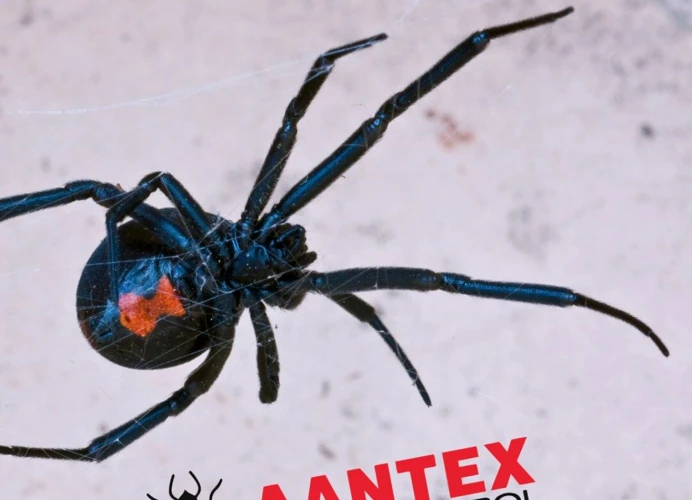
Keeping black widow spiders out of your home and yard is one of the best ways to prevent an infestation. By taking a few preventative measures, you can significantly reduce the likelihood of these venomous arachnids taking up residence in your living spaces. Here are some practical tips and tricks to keep your home and outdoor areas free of black widow spiders.
Home Maintenance
One of the keys to preventing a black widow spider infestation in your home is to keep up with regular home maintenance. This not only helps keep spiders out but also helps identify any potential hiding spots before they become a problem. Here are some simple home maintenance tips to keep your home spider-free:
| Tip | Description |
|---|---|
| Sealing | Seal any cracks or gaps around doors, windows, and pipes to prevent spiders from entering the house. Use silicone caulk or weather stripping for sealing. |
| Cleaning | Keep your home clean and tidy. Regularly vacuum, dust, and sweep the floors, walls, and ceilings. Pay extra attention to corners, baseboards, and closets. |
| Outdoor Gear | Store outdoor gear such as shoes, jackets, and gardening tools in enclosed containers to prevent spiders from hiding in them. |
| Garbage | Make sure to dispose of garbage in sealed containers and keep it away from the house. Trash cans should have tight-fitting lids. |
| Lighting | Eliminate or reduce outdoor lighting around the perimeter of your home and keep indoor rooms dimly lit. This decreases the likelihood of attracting insects, which in turn can attract black widow spiders. |
By following these home maintenance tips, you can make your home less attractive to black widow spiders and help to keep them from entering in the first place. Remember, prevention is always easier than trying to get rid of an infestation once it’s already established.
Outdoor Landscaping
When it comes to preventing black widow spider infestations, outdoor landscaping plays a crucial role. Here are some tips on how to limit the number of hiding spots for these venomous creatures:
- Keep grass and shrubs trimmed: Tall grass and overgrown shrubs provide ideal hiding spots for black widow spiders. Keep your grass trimmed and regularly prune your shrubs to keep them from becoming overgrown.
- Eliminate clutter: Piles of debris, such as wood, leaves, and rocks, can create the perfect environment for black widow spiders. Get rid of any unnecessary clutter around your yard and store firewood at least 20 feet away from your home.
- Seal off entry points: Inspect the exterior of your home and seal off any potential entry points for spiders, such as cracks in the foundation, gaps around doors and windows, and holes in screens.
- Use mulch sparingly: While mulch can be aesthetically pleasing, it can also provide a cozy hiding place for black widow spiders. If you choose to use mulch, avoid piling it up against the foundation of your home.
- Avoid dense plantings: Dense plantings can provide the ideal hiding spot for black widow spiders. Plant your flowers, shrubs, and trees with plenty of space in between to keep these spiders from nesting.
- Regularly clean your outdoor furniture: Black widow spiders may also seek refuge in outdoor furniture. Regularly clean your chairs and tables to keep them from becoming a hiding spot for these venomous creatures.
By implementing these outdoor landscaping tips, you can significantly reduce the number of hiding spots for black widow spiders and create a less hospitable environment for them in your yard.
Natural Repellents and Pesticides
One way to prevent black widow spider infestations is by using natural repellents and pesticides. These methods can be effective and safe alternatives to harsh chemicals. However, it’s important to note that natural repellents and pesticides may not be as potent as chemical ones and may require more frequent application.
Here are some examples of natural repellents and pesticides that can be used to deter black widow spiders:
| Peppermint Oil | Black widow spiders are repelled by the smell of peppermint oil. Mix a few drops of peppermint oil with water in a spray bottle and apply around your home and yard. |
| Diatomaceous Earth | Diatomaceous earth is a natural powder made from fossilized diatoms. It can be sprinkled around your home and yard to kill black widow spiders and other pests. The powder cuts the spiders’ exoskeletons, causing them to dry out and die. |
| Vinegar | Vinegar is an effective natural cleaner and repellent. Mix equal parts vinegar and water in a spray bottle and apply around your home and yard. |
| Citrus | The smell of citrus, such as orange and lemon peels, can repel black widow spiders. Leave citrus peels around your home and yard to deter spiders. |
| Eucalyptus Oil | Eucalyptus oil has a strong scent that black widow spiders don’t like. Mix a few drops of eucalyptus oil with water in a spray bottle and apply around your home and yard. |
It’s important to keep in mind that natural repellents and pesticides may not fully eliminate black widow spider infestations. Use these methods in combination with other prevention techniques, such as home maintenance and outdoor landscaping, for the best results.
What to Do If You Find a Black Widow Spider
Encountering a black widow spider can be a startling and concerning experience. Known for their venomous bites, it’s important to know the proper actions to take if you come across one. While it’s natural to feel anxious, panicking can exacerbate the situation. Remain calm and follow the steps below, emphasizing safety and caution at all times.
Safety Precautions
Safety Precautions
Black widow spiders are venomous and their bites can be dangerous to humans. It is important to take necessary safety precautions when dealing with these spiders. Here are some safety tips to keep in mind:
| Wear protective clothing | When inspecting or removing black widow spiders, it is important to wear protective clothing such as long-sleeved shirts, pants, gloves, and closed-toe shoes to prevent any bites. |
| Avoid handling the spiders | Black widow spiders are not aggressive but will bite if they feel threatened or cornered. It is important to avoid handling them with bare hands. |
| Keep children and pets away | Children and pets are more vulnerable to black widow spider bites. It is important to keep them away from these spiders and their hiding spots. |
| Use caution when cleaning | When cleaning areas where you suspect black widow spiders are hiding, use caution. Wear protective clothing and use a vacuum cleaner to remove spider webs and spiders from the area. |
| Seek medical attention if bitten | If you have been bitten by a black widow spider, seek medical attention immediately. Symptoms may include muscle pain, cramps, spasms, vomiting, and difficulty breathing. |
By following these safety precautions, you can reduce the risk of getting bitten by a black widow spider and ensure your safety when dealing with these venomous spiders.
Removing Spiders
If you’ve located a black widow spider in your home or yard, it’s important to remove it promptly. Here are some steps to safely and effectively remove these venomous pests:
1. Wear Protective Gear: Before attempting to remove a black widow spider, put on gloves and long sleeves to protect yourself from potential bites.
2. Use a Jar or Container: A jar or container with a lid can be an effective tool to capture a spider. Carefully place the jar over the spider and slide a piece of paper or cardboard underneath to trap it. Then, carefully remove the jar to a safe location away from your home.
3. Vacuuming: If you don’t want to capture the spider, vacuuming may be another option. Use a vacuum cleaner with a hose attachment to remove the spider and its web. Once you’re finished, remove the vacuum bag and dispose of it outside.
4. Chemical Sprays: If you decide to use a chemical spray to kill the spider, be sure to read the label carefully and follow instructions. Many sprays can be harmful to pets and children, so keep them away from the area until the spray has dried completely.
5. Seek Professional Help: If you’re uncomfortable dealing with black widow spiders or suspect you have a larger infestation, it may be best to call a pest control professional to remove them safely and effectively.
Remember, black widow spiders can be venomous and potentially dangerous, so it’s important to take caution and use protective gear when attempting to remove them.
Professional Pest Control
When it comes to dealing with a black widow spider infestation, professional pest control services can provide effective and safe solutions. Pest control professionals have the necessary training, equipment, and knowledge to safely remove black widow spiders from your home or property.
One of the first things a professional pest control technician will do is inspect your property for signs of black widow spiders, as well as their hiding spots and common areas of activity. This can include areas such as crawl spaces, attics, and outdoor structures like sheds and woodpiles.
The pest control technician may use a variety of methods to remove the spiders, including:
| Method | Description |
|---|---|
| Chemical Treatments | The technician may use insecticides or other chemicals to kill black widow spiders and their eggs. This can include dusting, spraying, or baiting the spiders. |
| Physical Removal | The technician may use tools such as vacuums or gloved hands to physically remove black widow spiders from their hiding spots. This is often done in conjunction with other methods, like chemical treatments. |
| Preventative Measures | The pest control technician may recommend certain measures to prevent future black widow spider infestations. This can include sealing up cracks and gaps in your home, removing clutter and debris from your property, and using natural repellents like peppermint oil. |
It’s important to note that professional pest control services should always be conducted by a licensed and insured technician. The technician should also provide you with specific instructions on how to prepare for the treatment and any safety precautions you should take while the treatment is being conducted.
While professional pest control services may be more costly than other methods, they can provide a long-lasting and effective solution for dealing with a black widow spider infestation. It’s always best to consult with a professional before attempting to remove black widow spiders on your own, as their bites can be dangerous and potentially fatal.
Conclusion
After reading this article on identifying the most common hiding spots for black widow spiders, it is clear that these venomous arachnids can be found in a variety of environments, both indoors and outdoors. By understanding the behavior and anatomy of black widow spiders, it is easier to identify them and take steps to prevent infestations.
It is important to note that while black widow spiders can be dangerous, they typically only bite when provoked or threatened. However, if bitten, it is recommended to seek medical attention right away as their venom can cause serious symptoms.
To reduce the chances of encountering black widow spiders, it is crucial to keep a clean and well-maintained living space, both inside and out. Removing clutter, sealing entry points, and properly storing items can help prevent infestations. Using natural repellents and pesticides can also aid in keeping black widow spiders at bay.
If a black widow spider is found in the home or yard, it is best to take caution and avoid contact. Removal can be done through DIY methods, but it is important to ensure safety measures are taken to avoid getting bitten.
In conclusion, identifying the most common hiding spots for black widow spiders and taking preventative measures can ultimately lead to a safer and more comfortable living environment. Remember to always be cautious and seek professional help if needed.
Frequently Asked Questions
How dangerous are black widow spiders?
Black widow spiders are considered to be one of the most venomous spiders in North America, and their bites can be fatal if left untreated. It is important to seek medical attention if bitten by a black widow spider.
What do black widow spiders look like?
Black widow spiders have shiny black bodies with a distinctive red hourglass shape on the underside of their abdomen. Females are larger than males and have a rounder abdomen.
What is the natural habitat of black widow spiders?
Black widow spiders are typically found in warm, dry environments such as deserts, but they can also be found in other habitats such as forests and fields.
What should I do if I find a black widow spider in my home?
If you find a black widow spider in your home, it is best to leave it alone and contact a pest control professional to safely remove it.
How can I prevent black widow spider infestations?
You can prevent black widow spider infestations by keeping your home and outdoor environment clean and clutter-free, sealing cracks and crevices, and using natural repellents or pesticides if necessary.
Do black widow spiders only come out at night?
No, black widow spiders can be active during the day as well as at night.
What is the lifespan of a black widow spider?
The lifespan of a female black widow spider is typically around three years, while males typically only live for a few months.
Are there any natural predators of black widow spiders?
Yes, natural predators of black widow spiders include birds, lizards, and some species of wasps.
Can I get rid of black widow spiders on my own?
It is not recommended to attempt to remove black widow spiders on your own, as their bites can be dangerous and they can be difficult to eliminate completely without professional pest control.
Are there any home remedies for black widow spider bites?
No, home remedies for black widow spider bites are not recommended. It is important to seek medical attention immediately if bitten by a black widow spider.

